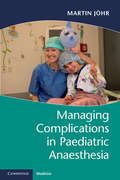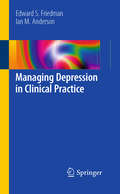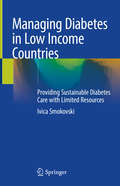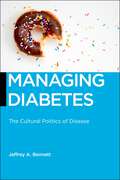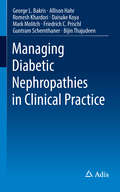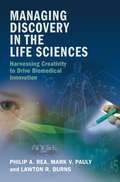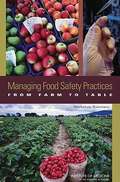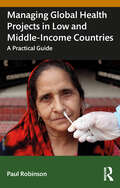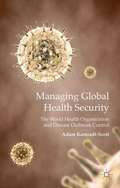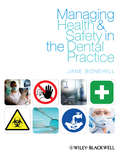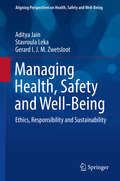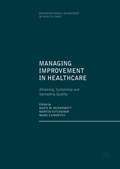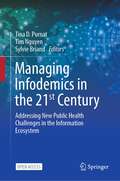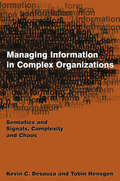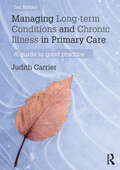- Table View
- List View
Managing Complications in Paediatric Anaesthesia
by Martin JöhrCommitted to providing safe anaesthetic care for paediatric patients, it is of paramount importance for clinicians to learn from suboptimal situations in order to continuously improve clinical performance. The first resource of its kind, this text analyses a selection of fascinating case studies and evaluates best practice in providing safe anaesthesia to children with recommendations on how to avoid the most common clinical pitfalls. Featuring over seventy chapters, topics include airway-related problems, vascular access, regional anaesthesia, medication related problems and the management of patients with pre-existing conditions. Each case study is supported by full colour images, making this essential reading for consultants and trainees in anaesthesia.
Managing Depression in Clinical Practice
by Edward S Friedman Ian M AndersonAn estimated 21 million people are diagnosed each year with a major depressive disorder in the USA, Western Europe and Japan. The economic cost of depression and its impact on sufferers and those around them is enormous. There are numerous therapy choices available, which can be daunting for the clinician trying to achieve the best treatment regimen. Managing Depression in Clinical Practice provides a concise overview of the clinical manifestation, diagnosis and management of this debilitating condition. The book gives practical coverage of depression in special populations, the management of treatment non-response and long-term treatment. Managing Depression in Clinical Practice is intended as an accessible text for family practitioners and psychiatrists in training and in practice. It will also be of interest to specialist nurses and allied health professionals working in the field.
Managing Diabetes in Low Income Countries: Providing Sustainable Diabetes Care with Limited Resources
by Ivica SmokovskiThis book covers the complexity of diabetes and related complications and presents the socio-economic burden of the disease, taking into account the rising prevalence reaching pandemic proportions and the associated costs. Factors causing high diabetes prevalence and the influence of the pharmaceutical industry are evaluated and solutions for sustainable diabetes care with limited resources are provided, including national focus on providing cost-effective diabetes treatment, nutrition and physical activity, structured diabetes education and centralized National e-Health System. Moreover, elaboration of long-term efforts to curb the diabetes burden through prevention activities are presented in this book.Managing Diabetes in Low Income Countries represents an essential guide for diabetes care clinicians and researchers, medical students and clinicians in training, diabetes policy makers, regulatory authorities, international diabetes and patient organisations all of whom are involved in current clinical practice for diabetes management.
Managing Diabetes: The Cultural Politics of Disease (Biopolitics #13)
by Jeffrey A. BennettA critical study of diabetes in the popular imaginationOver twenty-nine million people in the United States, more than nine percent of the population, have some form of diabetes. In Managing Diabetes, Jeffrey A. Bennett focuses on how the disease is imagined in public culture. Bennett argues that popular anecdotes, media representation, and communal myths are as meaningful as medical and scientific understandings of the disease. In focusing on the public character of the disease, Bennett looks at health campaigns and promotions as well as the debate over public figures like Sonia Sotomayor and her management of type 1 diabetes. Bennett examines the confusing and contradictory public depictions of diabetes to demonstrate how management of the disease is not only clinical but also cultural. Bennett also has type 1 diabetes and speaks from personal experience about the many misunderstandings and myths that are alive in the popular imagination. Ultimately, Managing Diabetes offers a fresh take on how disease is understood in contemporary society and the ways that stigma, fatalism, and health can intersect to shape diabetes’s public character. This disease has dire health implications, and rates keep rising. Bennett argues that until it is better understood it cannot be better treated.
Managing Diabetic Nephropathies in Clinical Practice
by George L. L. Bakris Allison Hahr Romesh Khardori Daisuke Koya Mark Molitch Friedrich C. C. Prischl Guntram Schernthaner Bijin ThajudeenAn overview of the diagnosis, treatment, and long-term management of diabetic-related kidney disease in clinical practice. Includes an evidence-based discussion of currently available and experimental drug therapies currently in development, guided by international consensus guidelines. Ideal for physicians, medical trainees, nurses and other medical professional that regularly screen and treat patients with all types of diabetes.
Managing Discovery in the Life Sciences: Harnessing Creativity to Drive Biomedical Innovation
by Mark V. Pauly Philip A. Rea Lawton R. BurnsIn this book, distinguished scholars Philip A. Rea, Mark V. Pauly, and Lawton R. Burns explore the science and management behind marketable biomedical innovations. They look at how the science actually played out through the interplay of personalities, the cultures within and between academic and corporate entities, and the significance of serendipity not as a mysterious phenomenon but one intrinsic to the successes and failures of the experimental approach. With newly aggregated data and case studies, they consider the fundamental economic underpinnings of investor-driven discovery management, not as an obstacle or deficiency as its critics would contend or as something beyond reproach as some of its proponents might claim, but as the only means by which scientists and managers can navigate the unknowable to discover new products and decide how to sell them so as to maximize the likelihood of establishing a sustainable pipeline for still more marketable biomedical innovations.
Managing Dismounted Complex Blast Injuries in Military & Civilian Settings
by Matthew J. Martin Joseph M. Galante Carlos J. Rodriguez Wade Travis GordonThis text is designed to present a comprehensive and state-of the-art approach to dismounted complex blast injuries. Sections address care of these patients from the point of injury through rehabilitation. The specific areas addressed include blast mechanics, stabilization and hemorrhage control at the point of injury, early resuscitation at local hospitals, a systematic approach to surgical care, and finally reconstruction and rehabilitation. Specific chapters focus on operative management of pelvic, abdominal, genitourinary, orthopedic, neurological and thoracic injuries. The authors of each chapter, are experts in treating DCBIs that have had direct hands-on experience through military deployments in Iraq and Afghanistan. Each chapter describes patient presentation and an algorithm outlining treatment with support from the literature. The text will conclude with three chapters. The first explores new advances in care that can be applied to these injuries. The second highlights the organization and team approach to care of these patients. Finally, the last chapter describes an actual case, cared for by the editors, that encompasses points from the chapters in the text. Extensive illustrations and flow diagrams are used throughout the text.This text is specifically designed to be a “how to” guide for inexperienced military and civilian providers. The chapters are organized in a step-wise fashion that mirrors the patient’s course from point of injury through their hospital course. Combining authors’ experience with illustrations and algorithm diagrams creates a text that is easy to use as a reference text or basis of training for future military and civilian surgeons.
Managing Ehealth
by Diane Whitehouse Magdalene Rosenmöller Petra WilsonThis book constitutes an excellent source of information for gaining a better understanding of information technologies in healthcare; for reviewing how healthcare will change as a consequence; and how to manage these changes in order to realise eHealth's full potential in creating value for patients, professionals and the system as a whole.
Managing Epilepsy with Women in Mind
by Timothy Betts Lyn GreenhillAt various stages in their life cycle, women with epilepsy have different needs from men and need a more female-orientated service. However, services for people with epilepsy remain androcentric and largely ignore that 50% of the recipients of epilepsy care in the United Kingdom are female. Indeed, 40% of those women engaged with epilepsy services
Managing Food Safety Practices FROM FARM TO TABLE: Workshop Summary
by Institute of Medicine of the National AcademiesLegal regulations and manufacturers' monitoring practices have not been enough to prevent contamination of the national food supply and protect consumers from serious harm. In addressing food safety risks, regulators could perhaps better ensure the quality and safety of food by monitoring food production not just at a single point in production but all along the way, from farm to table. Recognizing the troubled state of food safety, the Institute of Medicine's (IOM) Food Forum met in Washington, DC, on September 9, 2008, to explore the management of food safety practices from the beginning of the supply chain to the marketplace.
Managing Global Health Projects in Low and Middle-Income Countries: A Practical Guide
by Paul RobinsonWith over 30 years of experience in global health programming and teaching, the author offers practical and insightful guidance in this unique book for managing global health projects in resource-constrained settings.Beginning with an overview of fundamental principles, the book delves deeply into a ‘nuts and bolts’ approach to health project management. From building project teams and developing detailed activity plans to evaluating health projects and report writing, this book brings the readers a wealth of knowledge they can use to manage health projects. Besides a list of key takeaways and discussion questions, each chapter features a case study exercise from real life situation where readers can picture themselves as project managers, sharpening their understanding of concepts and strategies.Timely and original, this book is an essential resource for university students of global health courses preparing to manage global health projects in low- and middle-income countries, as well as for newly engaged project managers.
Managing Global Health Security
by Adam Kamradt-ScottThe author examines how the World Health Organization's approach to fulfilling its disease eradication mandate – now commonly described as 'global health security' – has changed and adapted over time. Drawing on constructivist and rationalist theories of international organization, as well as several case studies (malaria, smallpox, SARS, influenza, Ebola), the book explores how the organization's secretariat has exercised autonomy and authority to establish new customary practices and amend disease control policies and procedures in response to past failures and successes. Kamradt-Scott also investigates how the organization's member states have responded to these changes by imposing new constraints on the WHO's behaviour, and what these changes signal for the future.
Managing Health Effects Of Beryllium Exposure
by National Research Council of the National AcademiesBeryllium is a lightweight metal that is used for its exceptional strength and high heat-absorbing capability. Beryllium and its alloys can be found in many important technologies in the defense and aeronautics industries, such as nuclear devices, satellite systems, radar systems, and aircraft bushings and bearings. Pulmonary disease associated with exposure to beryllium has been recognized and studied since the early 1940s, and an occupational guideline for limiting exposure to beryllium has been in place since 1949. Over the last few decades, much has been learned about chronic beryllium disease and factors that contribute to its occurrence in exposed people. Despite reduced workplace exposure, chronic beryllium disease continues to occur. Those developments have led to debates about the adequacy of the long-standing occupational exposure limit for protecting worker health. This book, requested by the U.S. Air Force to help to determine the steps necessary to protect its workforce from the effects of beryllium used in military aerospace applications, reviews the scientific literature on beryllium and outlines an exposure and disease management program for its protecting workers.
Managing Health and Safety in the Dental Practice: A Practical Guide
by Jane BonehillThe main purpose of this book is to provide clear, straightforward information about the key requirements relating to health and safety in dental practices, with a practical and user-friendly approach to help manage these issues on a day-to-day basis. It assists practice managers, dentists, dental nurses and other team members in making health and safety 'second nature' by integrating it into their usual routine - thereby preventing accidents, addressing unacceptable working practices, and maintaining professional standards in order to ensure, so far as is reasonable, the protection of employees and patients. The book offers comprehensive coverage of all major topics, from the handling of hazardous substances to the management of medical emergencies. Each chapter includes: A tab for ease of reference A bulleted list outlining the scope of the chapter A list of figures An introduction to the subject and its relevance to the dental practice A list of key legislation relating to the subject The subject content broken down into sub-headings A summary to help reflection and recollection An action check list to measure against existing working practices frequently asked questions to assist in practical application Each topic is covered with specific reference to dental practice needs, with all the necessary detail but no excessive technicality. Ultimately, this book shows how a healthy and safe workplace is eminently achievable.
Managing Health, Safety and Well-Being: Ethics, Responsibility And Sustainability (Aligning Perspectives On Health, Safety And Well-being Ser.)
by Stavroula Leka Aditya Jain Gerard I.J.M. ZwetslootTo achieve sustainable progress in workplace and societal functioning and development, it is essential to align perspectives for the management of health, safety and well-being. Employers are responsible for providing every individual with a working environment that is safe and does not harm their physical or mental health. However, the current state of the art indicates that approaches used to promote health, safety and well-being have not had the anticipated results. At the level of the enterprise it is widely understood and accepted by all stakeholders that employers share the responsibility of promoting and managing the health of their workers. Evidence indicates that most employers put in place procedures and measures to manage workers’ health and create healthy workplaces to meet legal requirements, as a response to requests by employees, as a need to improve company image/reputation, and to improve productivity. This highlights that in addition to legal requirements, the key drivers for companies also include the ethical and business case. While much has been written about role of legislation and the business case for promoting health, safety and well-being, not much is known about the ‘ethical case’ for promoting employment and working conditions. In this context, this book examines the potential of the link between responsible and sustainable workplace practices, human rights and worker health, safety and well-being and explores how complementary approaches can be used to promote employment and working conditions and sustainability at the organizational level. It offers a framework for aligning different approaches and perspectives to the promotion of workers’ health, safety and well-being and provides recommendations for introducing such an approach at the enterprise level.
Managing Healthcare Organisations in Challenging Policy Contexts (Organizational Behaviour in Healthcare)
by Kathleen Montgomery Roman Kislov Diane Burns Bjørn Erik MørkHealthcare managers, professionals and service users operate in an increasingly complex environment in terms of policy, regulation and governance arrangements. The policy process is becoming pluralised as competing narratives are drawn upon to influence practice. A wide range of contradictory and inconsistent policies are on offer to healthcare stakeholders, which ultimately results in a broad spectrum of responses, adaptations and improvisations throughout the process of policy implementation. The impact on managerial and professional practice is significant: Whilst some voices are suppressed or ignored, the complex nature of contemporary policy contexts can also help local actors exercise their agency and advance their agenda.This edited volume investigates how contemporary policy trends are influencing healthcare systems, organisations and professions and explores the various ways in which policy implementation could be enacted, resisted and reinvented by healthcare managers and professionals on the ground. It sheds light on the complex web of connections that exist between policy development (Part I), its translation into practice (Part II), and the activities of organisational leaders who are trying their best to make sense of – and succeed in – challenging policy contexts (Part III).
Managing Heart Failure in Primary Care: A Case Study Approach
by K. Melissa Smith Hayes Nicole R. DelliseThis guide provides a clear and concise overview of heart failure for primary care clinicians. Written by two nurse practitioners for nurses, nurse practitioners, physician assistants, medical students, and pharmacists, it is uniquely designed to bridge the gap between cardiology and primary care. It delivers the most current recommendations outlined by the American Heart Association and the Heart Failure Society of America guidelines for the management and treatment of heart failure. This book includes a comprehensive overview of heart failure with reduced ejection fraction and heart failure with preserved ejection fraction. Special chapters are dedicated to physical exam, interpretation and application of diagnostic testing, and the management of chronic illness in the setting of acute and chronic heart failure. Additionally, the book provides clinicians with guidance on common medications to avoid, patient education, successful transitions of care, and conversations regarding goals of care. Each chapter includes an overview and learning objectives. The “Practice Pearls” and case studies found throughout the text highlight key takeaway points.
Managing Immunotherapy Related Organ Toxicities: A Practical Guide
by Yinghong WangCertain organ toxicities can be severe and life-threatening. Therefore, it is crucial to recognize these disease entities early on to provide prompt and effective treatments to improve the quality of patient care, and enable the continuation of cancer therapy long-term. A clinical handbook with a particular focus in this field is lacking. This handbook focuses on the comprehensive, systematic review of clinical aspects of immunotherapy-induced toxicities in 15 major organ systems. The organs covered include endocrine, eye, gut, heart, kidney, liver, lung, muscular-skeletal, neuro, pancreas and skin etc. A unique feature about this book is the inclusion of perspectives from Anesthesiology, Infectious Disease, and Pathology besides specific organ toxicity management. The contributors are a group of experts offering routine clinical care to patients with most complex and refractory toxicity conditions, conducting pioneering research, and providing the guidance for the clinical practice to the peers and trainees in the field. The topics of each chapter include incidence, clinical presentations, evaluation, management, and long term follow up of each disease entity. There is also a simplified management algorithm or table illustrated in each chapter as well as audio PowerPoint slide deck to provide straightforward general instruction on the evaluation and treatment.
Managing Improvement in Healthcare
by Aoife M. Mcdermott Martin Kitchener Mark ExworthyReflecting the challenges and opportunities of achieving improvement in healthcare systems, the contributions of this innovative new text lend depth and nuance to an increasing area of academic debate. Encompassing context, processes and agency, Managing Improvements in Healthcare addresses the task of attaining, embedding and sustaining improvement in the industry. The book begins by offering insight into the different valued aspects of quality, providing specific examples of national and organizational interventions in pursuit of improvement. The second part focuses on strategies for embedding good practice and ensuring the spread of high quality through knowledge mobilization, and the final part draws attention to the different groups of change agents involved in delivering, co-creating and benefitting from quality improvement. This inventive text will be insightful to those researchers interested in healthcare and organization, looking to transform theory into policy and practice.
Managing Infections in Patients With Hematological Malignancies
by Michael KleinbergManaging infections that complicate care of neutropenic patients with leukemia and hematopoietic stem cell recipients has become a distinct specialty. In Managing Infections in Patients with Hematological Malignancies, the authors and editor draw on their extensive expertise while providing a roadmap for hematologists to efficiently manage the complex infections within their patients. The first section of the text reviews viral, bacterial, and fungal pathogens, and provides brief descriptions of the microbes and diseases they cause in patients with hematological malignancies. The second section is devoted to management of infections in patients with the different underlying hematological malignancies, while the third addresses several important topics that are often ignored in most books about infections and hematological malignancies. Managing Infections in Hematological Malignancies is a useful tool for all clinicians and practicing hematologists who treat individual patients and aspire to build stronger infectious diseases programs within their respective cancer centers.
Managing Infodemics in the 21st Century: Addressing New Public Health Challenges in the Information Ecosystem
by Tina D. Purnat Tim Nguyen Sylvie BriandThis open access book on infodemic management reviews the current discussions about this evolving area of public health from a variety of perspectives. Infodemic management is an evidence-based practice underpinned by the science of infodemiology that offers guidance to better manage pandemic and epidemic risks and more quickly tackle new and resurgent health threats. Infodemic management has added much visibility and recognition for the importance of social-behavioural sciences, health communication, participatory and human-centered approaches, and digital health as complementary scientific and practical approaches that also must be strengthened in public health practice through a whole-of-society and whole information ecosystem approach. This volume makes a case that health of the information ecosystem in the digital age has emerged as the fourth ecosystem that public health is challenged by, along with the triad of environment-human-animal health. The book brings together scientists and practitioners across disciplines to offer insights on infodemic management. The tools, methods, analytics, and interventions that they discuss in the context of acute health events also can be applied to other public health areas. Topics covered include: People's Experience of Information Overload and Its Impact on Infodemic HarmsSmart Health! Expanding the Need for New LiteraciesTo Debunk or Not to Debunk? Correcting (Mis)informationPartnering with Communities for Effective Management of Health Emergencies Managing Infodemics in the 21st Century is required reading for public health practitioners in need of an overview of this evolving field of practice that has made major scientific and practical leaps forward since early 2020. Global, regional, and local health authorities are increasingly recognizing the need to expand their capacities for infodemic management in their efforts to better prepare for future health emergencies. This book is the resource they need to build toward a mature infodemic management process. The text also can be used as supplemental reading for graduate programs and courses in public health.
Managing Information and Knowledge in the Public Sector
by Eileen MilnerFor the public sector, which is globally the largest employer of people and repository of information, managing information and knowledge is an extremely problematic area to address. The essence of both resources is that they are intangible, their impact and value cannot be measured through traditional accounting methods, yet they are also, paradoxically, where the greatest value and potential for improvement is located. In this book Eileen Milner introduces the reader to the concepts of information and knowledge and explores a variety of tools and techniques which may be usefully adopted in actively managing and developing these resources. Wherever possible real-life public sector case studies and examples are used to illustrate good practice, as well as some of the pitfalls of poor application. Down-to-earth and taking into account the critically important characteristics unique to public services, this will be an illuminating text both for managers and policy makers already working in the public sector and for those considering doing so.
Managing Information in Complex Organizations: Semiotics and Signals, Complexity and Chaos
by Kevin C. Desouza Tobin HensgenThis seminal work presents an effective design for processing information through five stages from data to actionable knowledge in order to influence behavior within organizations. The authors incorporate such concepts as evolution, semiotics, entropy, complexity, emergence, crisis, and chaos theory in an intriguing alternative to crisis management that can be applied to any organization. Their model shows how to evaluate and share information to enable the organization to avoid disaster rather than simply respond to it. Additionally, the text presents the first attempt at a multi-disciplinary view of information processing in organizations by tying associated disciplines to their respective impacts on the information process. Illustrations used in the text include an overlay that demonstrates how the non-use of information between agencies contributed to the 9/11 disaster, and an appendix addresses Organizing for Cyberterrorism.
Managing Intense Emotions and Overcoming Self-Destructive Habits: A Self-Help Manual (Routledge Mental Health Classic Editions)
by Lorraine BellWhat is emotionally unstable personality disorder (EUPD), also known as borderline personality disorder, and how can people with EUPD learn how to manage their emotions more skilfully and effectively? Managing Intense Emotions and Overcoming Self-Destructive Habits is a self-help manual that will take you through that journey step by step.This book explains the problems that many people with EUPD struggle with, particularly intense emotional states and difficulties regulating them. It also outlines the skills needed to manage them, and explains how these skills can be learnt and developed. Featuring a brand new introduction by the author, subsequent chapters cover themes including: the condition and controversy surrounding the diagnosis drug and alcohol misuse emotional dysregulation and the role of thinking habits and beliefs depression and difficult mood states childhood abuse and relationship difficulties anger management This book is designed to be (ideally) used with the help of professional mental health staff, when a more evidence-based therapy is not available, or the person has tried and not got on with. This support and coaching can be given in a group or by individual sessions.This classic edition is essential reading for people with EUPD and professionals involved in their care—psychologists, psychiatric nurses, social workers, psychiatrists and occupational therapists.
Managing Long-term Conditions and Chronic Illness in Primary Care: A Guide to Good Practice
by Judith CarrierEffective management of long-term conditions is an essential part of contemporary nursing policy and practice. Systematic and evidence-based care which takes account of the expert patient and reduces unnecessary hospital admissions is vital to support those with long-term conditions/chronic diseases and those who care for them. Reflecting recent changes in treatment, the nurse’s role and the patient journey and including additional content on rehabilitation, palliative care, and non-medical prescribing, this fully updated new edition highlights the key issues in managing long-term conditions. It provides a practical and accessible guide for nurses and allied health professionals in the primary care environment and covers: -????????? the physical and psychosocial impact of long-term conditions -????????? effective case management -????????? self-management and the expert patient -????????? behavioural change strategies and motivational counselling -????????? telehealth and information technology -????????? nutritional and medication management. Packed with helpful, clearly written information, Managing Long-term Conditions and Chronic Illness in Primary Care includes case studies, fact boxes and pointers for practice. It is ideal reading for pre- and post-registration nursing students taking modules on long-term conditions, and will be a valuable companion for pre-registration students on community placements.
